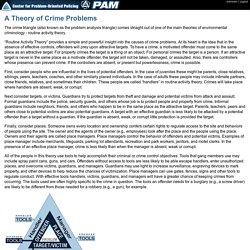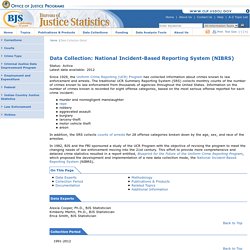

Rational Choice, Routine Activities, and Crime Pattern Theory - Crime and Place. Classical Theory in Criminology - College Essay - Wijayajayasinghe. Classical SchoolClassical theory in criminology has its roots in the theories of the 18th century Italian nobleman and economist, Cesare Beccaria and the English philosopher, Jeremy Bentham (Hollin, 2004, 2).

It was based on principles of utilitarian philosophy. Cesare Beccaria, author of On Crimes and Punishments (1763–64), Jeremy Bentham, inventor of the panopticon, and other classical school philosophers based their arguments as follows, (1) People have free will to choose how to act. Presenting theories in a column. Chapter 3: Rational Choice And Routine Activities Theory. This section of the report looks at rational choice theory and one of its subsidiaries, routine activities theory.

The discussion will commence with an explanation of each of the theoretical perspectives. The research literature is then reviewed, exploring the applicability and limitations of the perspectives. This is followed by a brief consideration of potential policy implications. Rational Choice Theory. Evaluate criminological theories, their interrelated concepts, and the influence of culture on crime. Criminal Justice - The 12 Criminology Theories flashcards. Chapter 3: Rational Choice And Routine Activities Theory.
A Theory of Crime Problems. The crime triangle (also known as the problem analysis triangle) comes striaght out of one of the main theories of environmental criminology - routine activity theory.

“Routine Activity Theory” provides a simple and powerful insight into the causes of crime problems. At its heart is the idea that in the absence of effective controls, offenders will prey upon attractive targets. To have a crime, a motivated offender must come to the same place as an attractive target. For property crimes the target is a thing or an object. For personal crimes the target is a person. First, consider people who are influential in the lives of potential offenders. Next consider targets, or victims. Finally, consider places. All of the people in this theory use tools to help accomplish their criminal or crime control objectives. Biological Theories of Deviance. Center for Evidence-Based Crime Policy. What Is the Strength of the NCVS When It Comes to Collecting Data on Crime?
Uniform Crime Report Pros and Cons. What is the uniform crime report?

It’s a collection of different statics on crime that covers the entire year. The goal of the report is to mine the data so that crime trends can be gauged. By doing this, responses in each community and region can be formulated so that growing trends in crime can be countered effectively. First conceived during the Prohibition era of the United States, this measurement of national crime has some pros and cons that must be considered. The Pros of the Uniform Crime Report It puts real crime data into a consumable format. Sources of Crime Data: Uniform Crime Reports and the National Incident-Based Reporting System. Two major sources of crime statistics commonly used in the United States are the Uniform Crime Reports (UCR) and the National Incident-Based Reporting System (NIBRS).

Uniform Crime Reports The UCR is the FBI’s widely used system for recording crimes and making policy decisions. It has tracked data on seven crimes since 1930: murder, robbery, rape, aggravated assault, burglary, theft and vehicle theft. In 1979, the UCR started reporting on arson. Nearly 17,000 law enforcement agencies report UCR data to the FBI but those data have several limitations that make them unsuitable for analyzing local crime. Intro & General Sources - Criminal Justice: Data and Statistics - LibGuides at Michigan State University Libraries. "The statistics of crime are known as the most unreliable and difficult of all statistics.

First, the laws which define crimes change. Second, the number of crimes actually committed cannot possibly be enumerated. The Nation's Two Crime Measures - Crime in the United States 2004. The U.S.

Department of Justice administers two statistical programs to measure the magnitude, nature, and impact of crime in the Nation: the Uniform Crime Reporting (UCR) Program and the National Crime Victimization Survey (NCVS). Each of these programs produces valuable information about aspects of the Nation’s crime problem. Because the UCR and NCVS programs are conducted for different purposes, use different methods, and focus on somewhat different aspects of crime, the information they produce together provides a more comprehensive panorama of the Nation’s crime problem than either could produce alone.
National Incident-Based Reporting System (NIBRS) Status: Active Latest data available: 2012 Since 1929, the Uniform Crime Reporting (UCR) Program has collected information about crimes known to law enforcement and arrests.

The traditional UCR Summary Reporting System (SRS) collects monthly counts of the number of crimes known to law enforcement from thousands of agencies throughout the United States. National Incident-Based Reporting System Resource Guide. About the National Incident-Based Reporting System (NIBRS) The National Incident Based Reporting System (NIBRS) is an incident-based reporting system for crimes known to the police.

For each crime incident coming to the attention of law enforcement, a variety of data is collected about the incident. About Statistical Briefing Book. More and more, OJJDP has been turning to high-tech solutions and the Internet to inform the public of new research findings and their implications for the juvenile justice field.

The OJJDP Statistical Briefing Book (SBB) enables users to access online information via OJJDP's website to learn more about juvenile crime and victimization and about youth involved in the juvenile justice system. Developed for OJJDP by the National Center for Juvenile Justice, SBB provides timely and reliable statistical answers to the most frequently asked questions from policymakers, the media, and the general public. In addition, the data analysis and dissemination tools available through SBB give users quick and easy access to detailed statistics on a variety of juvenile justice topics.
USA.gov | Privacy | Policies & Disclaimers | FOIA | Site Map | Ask a Question | OJJDP Home A component of the Office of Justice Programs, U.S. Department of Justice. Compendium of National Juvenile Justice Data Sets. Monitoring the Future (MTF), sponsored by the National Institute on Drug Abuse, is designed to elicit students' attitudes toward and experiences with drugs. The survey, which is given to between 14,000 and 18,000 high school seniors in 125 to 140 public and private schools, produces trends in drug use and attitudes in a nationally representative sample of high school seniors. Follow-up surveys also result in trends in use and attitudes in a nationally representative sample of young adults and college students.
Monitoring the Future has been conducted every year since 1975 by researchers at the Institute for Social Research (ISR), University of Michigan. In 1991, the survey was expanded to include 8th and 10th graders. Sampling proceeds in three stages. Approximately 125 to 140 public and private high schools and approximately 14,000 to 18,000 students are selected in order to provide a representative sample of high school seniors throughout the U.S. Johnston, L. National Crime Victimization Survey Resource Guide. About NCVS The National Crime Victimization Survey (NCVS) series, previously called the National Crime Survey (NCS), has been collecting data on personal and household victimization since 1973. An ongoing survey of a nationally representative sample of residential addresses, the NCVS is the primary source of information on the characteristics of criminal victimization and on the number and types of crimes not reported to law enforcement authorities. It provides the largest national forum for victims to describe the impact of crime and characteristics of violent offenders.
Twice each year, data are obtained from a nationally representative sample of roughly 49,000 households comprising about 100,000 persons on the frequency, characteristics, and consequences of criminal victimization in the United States. UCR NIBRS NCVS. UCR, NIBRS, and the NCVS The Uniform Crime Reporting (UCR) Program was conceived in 1929 by the International Association of Chiefs of Police to meet a need for reliable, uniform crime statistics for the nation. In 1930, the FBI was tasked with collecting, publishing, and archiving those statistics. Today, several annual statistical publications, such as the comprehensive Crime in the United States, are produced from data provided by law enforcement agencies across the United States. The UCR Program is a voluntary city, university and college, county, state, tribal and federal law enforcement program that provides a nationwide view of crime based on the submission of statistics by law enforcement agencies throughout the country.
In a given year, approximately 17,000 agencies contribute data to the FBI; however, because of computer problems, changes in record management systems, personnel shortages, or a number of other reasons, some agencies cannot provide data for publication. Juvenile Arrest Rate Trends. Following 5 years of decline, the juvenile Violent Crime Index arrest rate reached a new historic low-point in 2012. Juvenile Arrest Rates for Violent Crime Index Offenses, 1980-2012 [Text only] [Excel file] Rape and Sexual Assault Victimization Among College-Age Females, 1995–2013. About Statistical Briefing Book. Compendium of National Juvenile Justice Data Sets. The Compendium of National Juvenile Justice Data Sets is an online resource for researchers that is intended as an aid to investigations of juvenile offending, victimization, and contact with the juvenile justice system. It both publicizes data sources that users may find valuable and provides information intended to help with the practical aspects of obtaining and analyzing data.
The data sets described on this site cover a range of topics. National Crime Victimization Survey (NCVS) NCVS is the nation's primary source of information on criminal victimization. Intro & General Sources - Criminal Justice: Data and Statistics - LibGuides at Michigan State University Libraries. National Incident-Based Reporting System (NIBRS) Sources of Crime Data: Uniform Crime Reports and the National Incident-Based Reporting System. The Nation's Two Crime Measures - Crime in the United States 2004. Uniform Crime Report Pros and Cons. What Is the Strength of the NCVS When It Comes to Collecting Data on Crime?
Three-Pronged Crime Prevention Strategy Launched - Jamaica Information Service. Photo: JIS PhotographerMinister of National Security, Hon. Peter Bunting (2nd right); and Minister of Justice, Senator the Hon. Mark Golding (centre), discuss a model displaying features of the anti-crime mobile application, which is to be rolled out in January 2014. Also participating (from left) are: Chief of Defence Staff, Major General Antony Anderson; Permanent Secretary in the Ministry of National Security, Major General Stewart Saunders; and Police Commissioner, Owen Ellington. Occasion was the launch of a national collaborative crime prevention initiative, ‘United for Change’, at the Police Officers’ Club, on Hope Road, in Kingston, on December 5. Story Highlights ‘United for Change’ seeks to rekindle hope in the society and mobilise law-abiding citizens to work together as a united front against crime.
‘United for Change’ seeks to rekindle hope in the society and mobilise law-abiding citizens to work together as a united front against crime. The initiative, Mr. Mr. Mr. Mr. Duke University poverty study: When rich and poor live side-by-side, poor boys suffer most. Photo by Jewel Samad/AFP/Getty Images. Urban Crime - Explaining Variation In Urban Crime - Poverty, Racial, Studies, and Relationship. Although there is general consensus among criminologists that urban areas have higher rates of crime than rural areas, of less certainty is why certain urban settings have higher crime rates than other urban settings. That is, not all cities or neighborhoods experience similar levels of crime and violence; there is widespread variation in crime levels across urban spaces. Subculture of Violence Theory - The Encyclopedia of Theoretical Criminology - Hawley. 3) Subcultural Theories. Subcultural theories build upon the work of Merton. Chapter 9: The Subculture of Violence.
The search for the social causes of violence has been an ongoing preoccupation of criminologists since the early 20th century, when researchers attempted to look beyond biological and psychological explanations to understand crime. The shift in understanding violence as a social phenomenon, rather than an individual one, emerged from observations that incidents of violence tend to not be evenly distributed within society. Chapter 6: Strain Theories. Chapter 6: Strain Theories. Property Crime - Criminology - Oxford Bibliographies. PROPERTY CRIME. Criminology For Dummies Cheat Sheet. Violence Theory Workshop Summary. Social Theories of Crime. Chapter 3: Rational Choice And Routine Activities Theory. What Is Subculture? - Theories, Definition & Examples. Subcultures are those groups that have values and norms that are distinct from those held by the majority. Let's examine a few subcultural theories and test our knowledge with a quiz.
Explore our library of over 30,000 lessons Click "next lesson" whenever you finish a lesson and quiz. Chapter 11 Crimes of Violence. SOCIO-ECONOMIC THEORIES OF CRIME By: Aric Hall Completed in Partial Fulfillment of the Requirements for HS 8373 – Understandi. Crime Causation: Sociological Theories – FREE Crime Causation: Sociological Theories information. Crime Causation: Sociological Theories - Strain Theory - Delinquency, People, Money, and Engage. Crime. NCJRS Abstract - National Criminal Justice Reference Service. Societal strain. Social disorganization. Social control. Residents Of Low-Income Neighborhoods Care More For Their Communities, Study Finds.
The Poverty-Crime Connection. Explain how a relationship between income and the crime rate is not the same as income level causing crime. Poverty and Crime: Breaking a Vicious Cycle of Discrimination. Intro & General Sources - Criminal Justice: Data and Statistics - LibGuides at Michigan State University Libraries. U.S. Official Crime Stats - Criminal Justice: Data and Statistics - LibGuides at Michigan State University Libraries. Sources of Crime Data: Uniform Crime Reports and the National Incident-Based Reporting System.
Nation's Two Crime Measures. Data Archives - Criminal Justice: Data and Statistics - LibGuides at Michigan State University Libraries. Juvenile Victimization and Offending, 1993-2003. Crime Data Overview. Compendium of National Juvenile Justice Data Sets. The Nation's Two Crime Measures - Crime in the United States 2004. National Incident-Based Reporting System (NIBRS) Table of Conents, Section 3 - Sourcebook. Juvenile Victimization and Offending, 1993-2003. Creating Born Criminals - Nicole Hahn Rafter. Racial and Ethnic Disparities in Crime and Criminal Justice in the United States. Search.proquest.com.libproxy.edmc. Theoretical Perspectives on Race and Crime. Encyclopedia of Race and Crime. Intro & General Sources - Criminal Justice: Data and Statistics - LibGuides at Michigan State University Libraries.
Sources of Crime Data: Uniform Crime Reports and the National Incident-Based Reporting System. National Archive of Criminal Justice Data. All Data Collections. Combating Street Gangs.